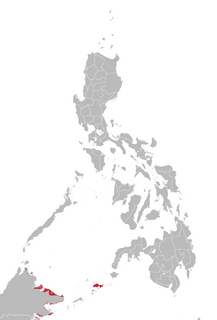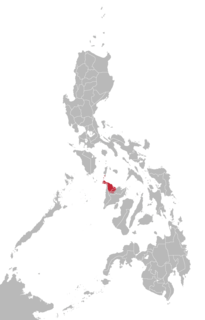Related Research Articles

Tagalog is an Austronesian language spoken as a first language by the ethnic Tagalog people, who make up a quarter of the population of the Philippines, and as a second language by the majority. Its standardized form, officially named Filipino, is the national language of the Philippines, and is one of two official languages, alongside English.

Cebuano, natively called by its generic term Bisaya or Binisaya and sometimes referred to in English sources as Cebuan, is an Austronesian language spoken in the southern Philippines. It is spoken by the Visayan ethnolinguistic groups native to the islands of Cebu, Bohol, Siquijor, the eastern half of Negros, the western half of Leyte, and the northern coastal areas of Northern Mindanao and the Zamboanga Peninsula. In modern times, it has also spread to the Davao Region, Cotabato, Camiguin, parts of the Dinagat Islands, and the lowland regions of Caraga, often displacing native languages in those areas.

Juǀʼhoan, also known as Southern or Southeastern ǃKung or ǃXun, is the southern variety of the ǃKung dialect continuum, spoken in northeastern Namibia and the Northwest District of Botswana by San Bushmen who largely identify themselves as Juǀʼhoansi. Several regional dialects are distinguished: Epukiro, Tsumǃkwe, Rundu, Omatako and ǂKxʼauǁʼein, with Tsumǃkwe being the best described and often taken as representative.

The Bisayan languages or Visayan languages are a subgroup of the Austronesian languages spoken in the Philippines. They are most closely related to Tagalog and the Bikol languages, all of which are part of the Central Philippine languages. Most Bisayan languages are spoken in the whole Visayas section of the country, but they are also spoken in the southern part of the Bicol Region, islands south of Luzon, such as those that make up Romblon, most of the areas of Mindanao and the province of Sulu located southwest of Mindanao. Some residents of Metro Manila also speak one of the Bisayan languages.

Tausug is an Austronesian language spoken in the province of Sulu in the Philippines and in the eastern area of the state of Sabah, Malaysia, by the Tausūg people. It is widely spoken in the Sulu Archipelago, the Zamboanga Peninsula, southern Palawan, and Malaysia.

Maranao is an Austronesian language spoken by the Maranao people in the provinces of Lanao del Norte and Lanao del Sur in the Philippines, and in Sabah, Malaysia.
The Central Philippine languages are the most geographically widespread demonstrated group of languages in the Philippines, being spoken in southern Luzon, Visayas, Mindanao, and Sulu. They are also the most populous, including Tagalog, Bikol, and the major Visayan languages Cebuano, Hiligaynon, Waray, Kinaray-a, and Tausug, with some forty languages all together.

Masbateño or Minasbate is a member of Central Philippine languages and of the Bisayan subgroup of the Austronesian language family spoken by more than 724,000 people in the province of Masbate and some parts of Sorsogon in the Philippines. Masbatenyo is the name used by the speakers of the language and for themselves, although the term Minásbate is sometimes also used to distinguish the language from the people. It has 350,000 speakers as of 2002, with 50,000 who speak it as their first language. About 250,000 speakers use it as their second language.
Aleph is the first letter of the Semitic abjads, including Phoenician ʾālep 𐤀, Hebrew ʾālef א, Aramaic ʾālap 𐡀, Syriac ʾālap̄ ܐ, Arabic ʾalif ا and North Arabian 𐪑. It also appears as South Arabian 𐩱 and Ge'ez ʾälef አ.

Aklanon (Akeanon), also known as Bisaya/Binisaya nga Aklanon/Inaklanon or simply Aklan, is an Austronesian language of the Bisayan subgroup spoken by the Aklanon people in the province of Aklan on the island of Panay in the Philippines. Its unique feature among other Bisayan languages is the close-mid back unrounded vowel occurring as part of diphthongs and traditionally written with the letter ⟨Ee⟩ such as in the autonyms Akean and Akeanon. However, this phoneme is also present in other but geographically scattered and distant Philippine languages, namely Itbayat, Isneg, Manobo, Samal and Sagada.
Saanich is the language of the First Nations Saanich people in the Pacific Northwest region of northwestern North America. Saanich is a Coast Salishan language in the Northern Straits dialect continuum, the varieties of which are closely related to the Klallam language.
Dâw is a Nadahup language spoken by about one hundred Dâw people in the northwestern part of Amazonas, Brazil, in an area commonly known as Alto Rio Negro. Most Dâw also speak Nheengatu and Portuguese.

The Bukid language, Binukid or Bukidnon, is an Austronesian language spoken by indigenous peoples of Northern Mindanao in southern Philippines. The word Bukid means "mountain" or “highland” while Binukid means "in the manner, or style, of the mountain or highland". In Bukidnon province, it is referred to as Higaonon.
The Proto-Philippine language is a reconstructed ancestral proto-language of the Philippine languages, a proposed subgroup of the Austronesian languages which includes all languages within the Philippines as well as those within the northern portions of Sulawesi in Indonesia. Proto-Philippine is not directly attested to in any written work, but linguistic reconstruction by the comparative method has found regular similarities among languages that cannot be explained by coincidence or word-borrowing.

The Sama language, Sinama, is the language of Sama-Bajau people of the Sulu Archipelago, Philippines; Sabah, Malaysia and parts of Indonesia. The Sama are one of the most widely dispersed peoples in Southeast Asia.

The Karay-a language is an Austronesian regional language in the Philippines spoken by the Karay-a people, mainly in Antique, Iloilo, Guimaras, and other provinces on the island of Panay, as well as portions of the Soccsksargen region in Mindanao and Palawan.

Hiligaynon, also often referred to as Ilonggo or Binisaya/Bisaya nga Hiniligaynon/Inilonggo, is an Austronesian regional language spoken in the Philippines by about 9.1 million people, predominantly in Western Visayas and Soccsksargen, most of whom belong to the Hiligaynon people. It is the second-most widely spoken language in the Visayas and belongs to the Bisayan languages, and is more distantly related to other Philippine languages.

Waray is an Austronesian language and the fifth-most-spoken native regional language of the Philippines, native to Eastern Visayas. It is the native language of the Waray people and second language of the Abaknon people of Capul, Northern Samar, and some Cebuano-speaking peoples of western and southern parts of Leyte island. It is the third most spoken language among the Bisayan languages, only behind Cebuano and Hiligaynon.

Ilocano is an Austronesian language spoken in the Philippines, primarily by Ilocano people and as a lingua franca by the Igorot people. It is the third most-spoken native language in the country.
The phonological system of the Hejazi Arabic consists of approximately 26 to 28 native consonant phonemes and 8 vowel phonemes:, in addition to 2 diphthongs:. Consonant length and vowel length are both distinctive in Hejazi.
References
- ↑ Bantayanon at Ethnologue (18th ed., 2015) (subscription required)
- ↑ Alcina, Ignacio Francisco (2002). Kobak, Cantius; Gutiérrez, Lucio (eds.). History of the Bisayan People in the Philippine Islands. Evangelization and Culture at the Contact Period (Historia de La Islas e Indios de Bisayas... 1668). Vol. 1. Manila: UST Publishing House. pp. 78–79.
- ↑ Zorc, R. David Paul (1977). The Bisayan Dialects of the Philippines: Subgrouping and Reconstruction . Pacific Linguistics, Series C – No. 44. Canberra: Australian National Univiversity. doi: 10.15144/PL-C44 .
- ↑ Carabio-Sexon, Minda. 2007. “Bantayanon: A Lexical Comparison and Sociolinguistic Description.” Mindanao State University - Iligan Institute of Technology.